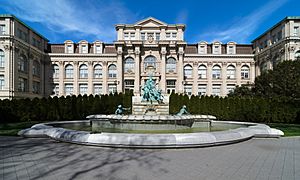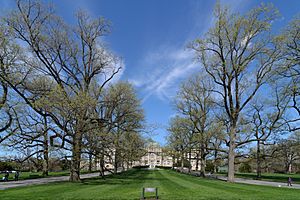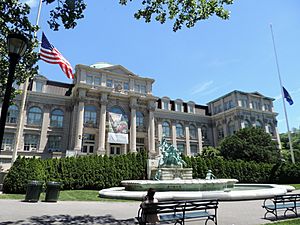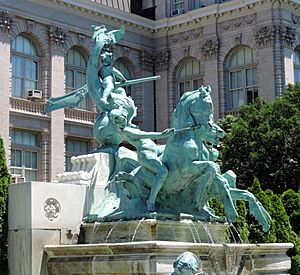LuEsther T. Mertz Library facts for kids
Quick facts for kids LuEsther T. Mertz Library |
|
|---|---|
 |
|
| NYBG Library Building | |
| Country | United States |
| Type | Research library |
| Location | New York Botanical Garden 2900 Southern Boulevard The Bronx, NY 10458 |
| Coordinates | 40°52′00″N 73°52′44″W / 40.86667°N 73.87889°W |
The LuEsther T. Mertz Library is a special library for research. It is located at the New York Botanical Garden in the Bronx, New York City. This library started in 1899. It was later renamed in the 1990s after LuEsther Mertz. It is the biggest library in the United States focused only on plants. It was also the first library to collect only plant-related materials.
The library has huge collections of books about plants and gardening. These books help people study many subjects. This includes history, how buildings are designed, and how people use plants. The library has new scholarly books and also many rare and old books.
The library building was designed in 1896 by Robert W. Gibson. It was built between 1898 and 1901. The building looks like the Renaissance Revival style. It is four stories tall. Its outside walls are made of gray-buff brick and buff terracotta. Outside the main entrance, there is a cool fountain called the Fountain of Life. There is also a tree-lined path called the Tulip Tree Allee. In 2009, the library building, the fountain, and the path became a New York City landmark.
Contents
Discovering the Mertz Library's Past
How the Library Started
In 1891, a law was passed in New York State. This law set aside land in Bronx Park for the New York Botanical Garden (NYBG). But first, a group of leaders had to raise $250,000. Important leaders and money people agreed to help. By May 1895, enough money was raised.
In March 1896, a survey of the land was finished. Plans included a three-story museum for the NYBG. It would be near the main entrance. This museum would be the first in the U.S. to focus only on plants. The museum was placed on a hilltop. This made it easy to reach from the Botanical Garden train station.
A design competition was held for the museum. Many architects joined. Robert W. Gibson won the contest. He submitted his building plans in November 1896. In January 1897, the city said NYBG could start building the museum.
Building the Library
Building started slowly because of arguments. Some people thought the museum and the NYBG conservatory would spoil the garden's natural look. But the city had already hired architects. They were asking for money to build. In September 1897, the city finally approved $500,000 for the project.
Construction began on December 31, 1897. By May 1898, the brick walls were going up. By September 1898, the steel frame was almost done. The outside walls were built up to the second floor. The building was mostly finished by March 1900.
After the Building Was Done
The library first had 2,500 books. In 1899, Columbia College donated 5,000 more plant books. In 1901, a contract was made to build the fountain and front paths.
The library's collection grew a lot. By 1926, people planned to add more space to the building. But this didn't happen right away. In 1958, a new three-story addition was suggested. It would be built behind the main building. This new part would have classrooms, offices, and reading rooms. In 1964, Mayor Robert F. Wagner Jr. approved the addition. It was named the Harriet Barnes Pratt Library Wing. It opened in 1966.
A new Science and Education Building was built from 1969 to 1972. By 1988, the plant collection (herbarium) filled all empty spaces. So, NYBG planned a four-story expansion. This new part would be on the east side. A big restoration of the main hall (rotunda) was finished in November 1988.
A one-story addition for plant specimens was finished in 1994. In the mid-1990s, the library was renamed after LuEsther Mertz. She was a big supporter of NYBG. In 1997, plans for a northern addition were finalized. This new part, called the International Plant Science Center, would cost $39 million. It would have new research rooms, library space, and a new entrance. Construction started in 1998 and finished in 2002. After this, the library collections moved to the new annex. The original building was then called the Library Building.
The Library's Design and Features
The original Mertz Library building was designed by Robert W. Gibson. Its front is 308 feet long. It has a central part with a dome and two side wings. The building is on uneven ground. So, the basement is at ground level on some sides.
The building has four main additions. The International Plant Science Center is east of the north wing. The Jeannette Kittredge Watson Science and Education Building is east of the south wing. There is also a one-story annex to the south. The Harriet Barnes Pratt Library Wing is behind the original building.
Outside the Library
The outside of the original building has buff and gray brick. It also has terracotta decorations. Most windows are rectangular. But the second floor has round-arched windows with small railings. The third story has a sloped roof with windows sticking out. The building has tall, flat columns called pilasters. A decorative ledge runs along the second story. A glass dome sits over the third-story rotunda. It rises 36 feet above the third floor.
On the front (west) side, the central part has a grand entrance. It has a triangular top supported by four tall columns. These columns divide the center into three sections. There are three sets of doors on the first floor. Above the middle door, you can see the seal of New York City. The seals of New York state and the United States are on the sides. On the third story, there is a special carving of the New York Botanical Garden's symbol. The steps leading to the entrance are made of granite.
The sides and back of the building look similar. They also have windows in the basement. Some parts of the back and north side are now hidden by the newer additions.
Library Additions
The International Plant Science Center is five stories tall. It has a sand-colored outside with no windows.
The Harriet Barnes Pratt Library Wing is six stories high. It looks similar to the original library building.
The Jeannette Kittredge Watson Science and Education Building is four stories high. It has a steel frame and glass walls. It also has green panels.
Inside the Library
The original building has a steel frame and concrete floors. The basement has the Arthur and Janet Ross Lecture Hall. It can hold 400 people. The first floor used to have a museum about plants used for food and other things. The second floor had a general plant museum. The third floor had the library, reading rooms, and plant specimen collections (herbaria). After a 2002 update, the library also got a 48-foot long wooden reference desk. It also has a study room with 50 seats.
Since the International Plant Science Center opened, the library collections and the herbarium are now in that building. The William & Lynda Steere Herbarium is one of the biggest plant collections in the world. It has about 7.2 to 7.8 million plant specimens!
The Science and Education Building has offices and classrooms. It also has a greenhouse to create different plant environments. It is connected to the original building. This building is used by the NYBG's School of Professional Horticulture. Plant specimens are also stored in the one-story addition connected to the south wing.
Special Features Outside the Library
Fountain of Life
The Fountain of Life is in front of the library's main entrance. Carl Tefft designed it, and it was finished in 1905. The fountain has amazing sculpted figures. There are two horses with webbed front feet. A woman sits on one horse. A boy tries to control the other horse while holding a fish. Another boy sits on a dolphin. In the fountain's pool, there is a bronze merman on a crab and a bronze mermaid. They both look surprised. This fountain was unique because of the webbed-foot horses. People said it looked like the exciting fountains from Italy.
The fountain was planned with the museum in 1897. But only the granite base was built by 1900. NYBG held a design contest for the bronze statue. Carl Tefft's design was chosen in 1903. The statue was cast in Brooklyn. It was finished in May 1905 and put in place that July.
The fountain was cleaned in 1968 because it was getting old. Some parts were removed. In 2005, the mermaid, merman, and a crab claw were replaced. A bronze book was also put in the pool. The fountain was then named for Lillian Goldman, a generous donor.
The Grand Avenue
In 1901, a contract was given to pave a road and plant trees. This created a beautiful path leading to the museum building. It was finished in 1902. The path originally had a seating area and a tall drinking fountain. These were removed in the 1950s. Trees like Carolina poplars and tulip trees were planted along the path. The poplars were removed by 1911. Today, the paths have benches, an asphalt surface, and concrete edges.
Who Led the Library?
Here are some of the people who have been in charge of the library:
- D.T. MacDougal (acting librarian, 1899)
- Anna Murray Vail (January 1900 – September 1907)
- John Hendley Barnhart (October 1907 – December 1912)
- Sarah Harlow (January 1913 – October 1937)
- Elizabeth C. Hall (November 1937 – 1960)
- James J. Daly, Administrative Librarian (1960–1961)
- Robert Jones, Administrative Librarian, 1962
- Mulford Martin, Acting Senior Curator of the Library (1964–1965)
- John F. Reed, Curator of the Library (1965–1971)
- Charles R. Long, Administrative Librarian (1972–1986)
- John F. Reed, VP for Education and Director of the Library (November 1992 – June 2003)
- Susan Fraser, Director of the Library (2004 – present)
What's in the Collection?
When it first opened, the Mertz Library was the biggest plant library in the U.S. It was also one of the largest in the world. In 2002, a New York Times article said the library had 775,000 items. It also had 6.5 million plant specimens. The Times also said the Mertz Library had most of the world's plant science literature. It also had 70% of all published plant guides.
However, a book from 2014 said the library had "550,000 physical volumes and 1,800 journal titles." As of 2016, the Mertz Library still has one of the world's largest collections of plant-related books. Stephen Sinon, who leads the special collections, called it "the largest of its kind in the world under one roof."
The collection grew by buying books and getting donations. Many famous plant experts, gardeners, and scientists gave their libraries. Items were also collected from NYBG trips around the world. The collection includes rare plant books. For example, it has two copies of the Circa Instans from around 1190 and 1275. Some personal collections given to the library include those from:
- Eleanor Cross Marquand
- Sarah Gildersleeve Fife
- Lucien Marcus Underwood
- Robert Hiester Montgomery
- Emil Starkenstein
- John Torrey
- Harriet Barnes Pratt
- David Hosack





